Melbourne Franchising Expo: Events Policy and Strategy Reflection
VerifiedAdded on 2022/10/04
|6
|1527
|478
Journal and Reflective Writing
AI Summary
This reflective journal analyzes the Melbourne Franchising & Business Opportunities Expo, held in Melbourne, Australia, focusing on its significance in the business world. The journal explores the event's role in connecting franchisors and franchisees, highlighting the opportunities available to entrepreneurs and established brands. It details the event's structure, including exhibitor profiles, ticket pricing, and venue details, and discusses the event's impact on various industries, particularly hospitality and tourism. The author reflects on the event's organization, the importance of event management strategies, and the potential for globalization and cultural exchange. The journal also covers the activities involved in setting up the two-day event and the author's enhanced understanding of event strategies and management. The assignment uses references to support the claims made in the journal.
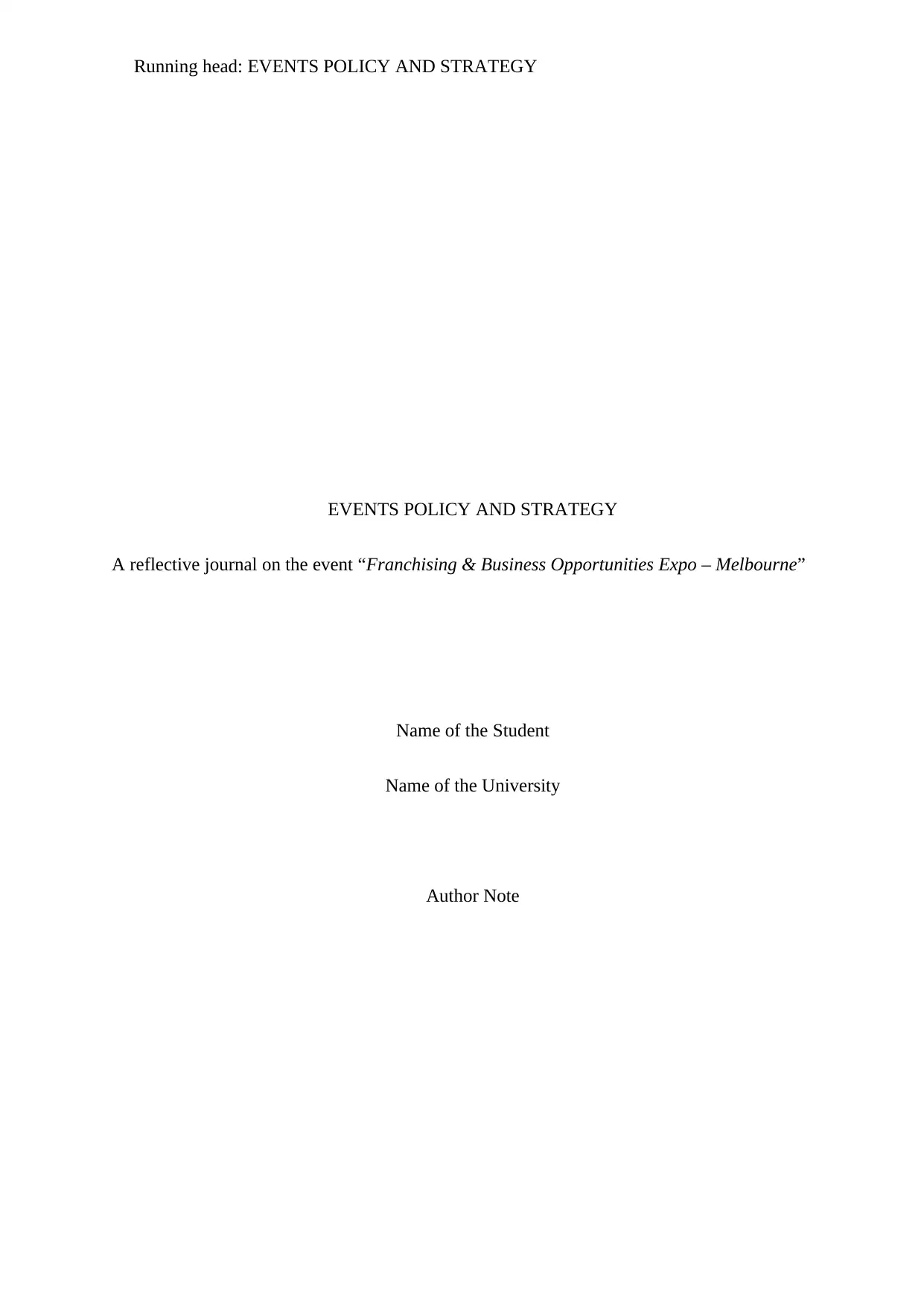
Running head: EVENTS POLICY AND STRATEGY
EVENTS POLICY AND STRATEGY
A reflective journal on the event “Franchising & Business Opportunities Expo – Melbourne”
Name of the Student
Name of the University
Author Note
EVENTS POLICY AND STRATEGY
A reflective journal on the event “Franchising & Business Opportunities Expo – Melbourne”
Name of the Student
Name of the University
Author Note
Paraphrase This Document
Need a fresh take? Get an instant paraphrase of this document with our AI Paraphraser
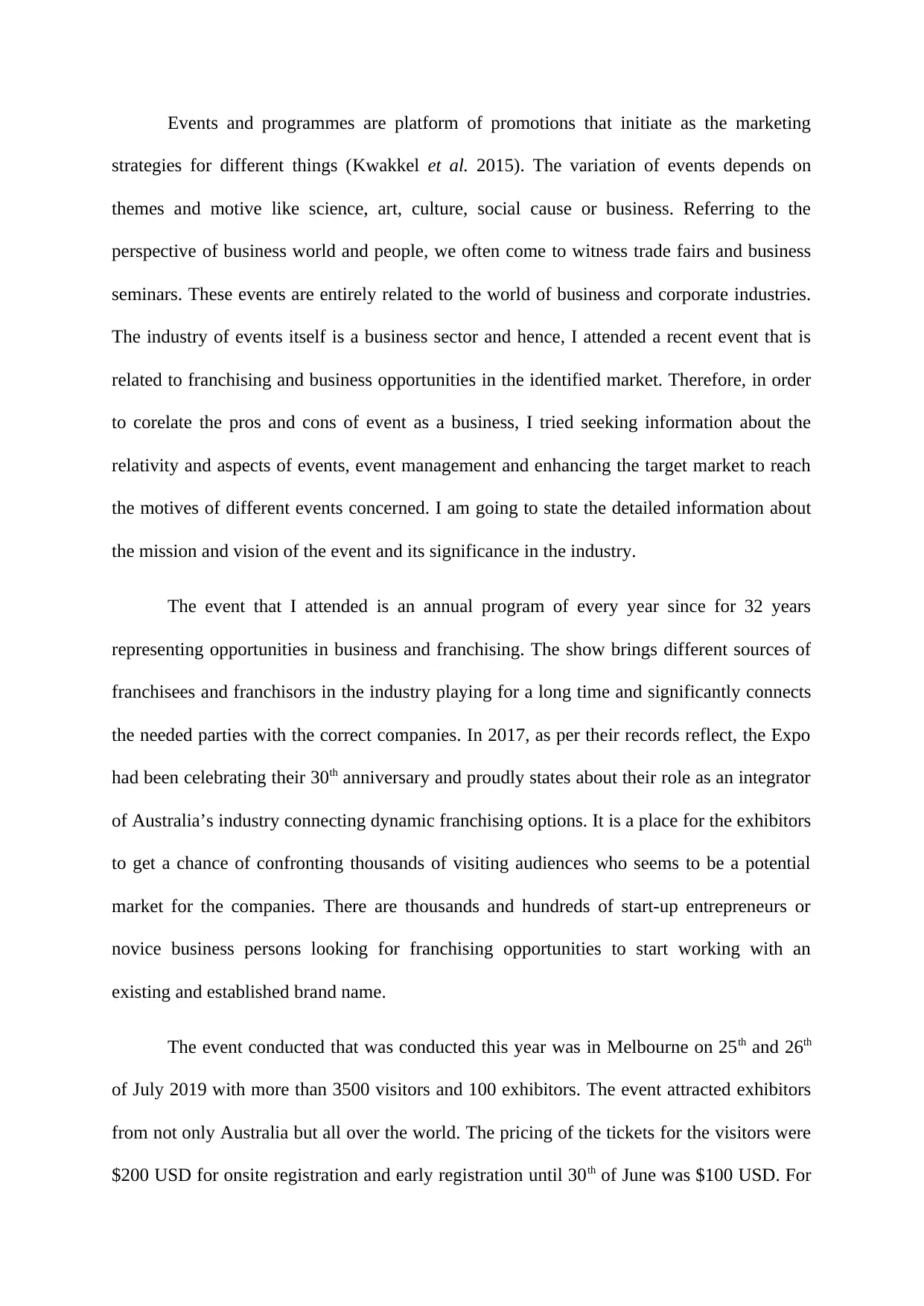
Events and programmes are platform of promotions that initiate as the marketing
strategies for different things (Kwakkel et al. 2015). The variation of events depends on
themes and motive like science, art, culture, social cause or business. Referring to the
perspective of business world and people, we often come to witness trade fairs and business
seminars. These events are entirely related to the world of business and corporate industries.
The industry of events itself is a business sector and hence, I attended a recent event that is
related to franchising and business opportunities in the identified market. Therefore, in order
to corelate the pros and cons of event as a business, I tried seeking information about the
relativity and aspects of events, event management and enhancing the target market to reach
the motives of different events concerned. I am going to state the detailed information about
the mission and vision of the event and its significance in the industry.
The event that I attended is an annual program of every year since for 32 years
representing opportunities in business and franchising. The show brings different sources of
franchisees and franchisors in the industry playing for a long time and significantly connects
the needed parties with the correct companies. In 2017, as per their records reflect, the Expo
had been celebrating their 30th anniversary and proudly states about their role as an integrator
of Australia’s industry connecting dynamic franchising options. It is a place for the exhibitors
to get a chance of confronting thousands of visiting audiences who seems to be a potential
market for the companies. There are thousands and hundreds of start-up entrepreneurs or
novice business persons looking for franchising opportunities to start working with an
existing and established brand name.
The event conducted that was conducted this year was in Melbourne on 25th and 26th
of July 2019 with more than 3500 visitors and 100 exhibitors. The event attracted exhibitors
from not only Australia but all over the world. The pricing of the tickets for the visitors were
$200 USD for onsite registration and early registration until 30th of June was $100 USD. For
strategies for different things (Kwakkel et al. 2015). The variation of events depends on
themes and motive like science, art, culture, social cause or business. Referring to the
perspective of business world and people, we often come to witness trade fairs and business
seminars. These events are entirely related to the world of business and corporate industries.
The industry of events itself is a business sector and hence, I attended a recent event that is
related to franchising and business opportunities in the identified market. Therefore, in order
to corelate the pros and cons of event as a business, I tried seeking information about the
relativity and aspects of events, event management and enhancing the target market to reach
the motives of different events concerned. I am going to state the detailed information about
the mission and vision of the event and its significance in the industry.
The event that I attended is an annual program of every year since for 32 years
representing opportunities in business and franchising. The show brings different sources of
franchisees and franchisors in the industry playing for a long time and significantly connects
the needed parties with the correct companies. In 2017, as per their records reflect, the Expo
had been celebrating their 30th anniversary and proudly states about their role as an integrator
of Australia’s industry connecting dynamic franchising options. It is a place for the exhibitors
to get a chance of confronting thousands of visiting audiences who seems to be a potential
market for the companies. There are thousands and hundreds of start-up entrepreneurs or
novice business persons looking for franchising opportunities to start working with an
existing and established brand name.
The event conducted that was conducted this year was in Melbourne on 25th and 26th
of July 2019 with more than 3500 visitors and 100 exhibitors. The event attracted exhibitors
from not only Australia but all over the world. The pricing of the tickets for the visitors were
$200 USD for onsite registration and early registration until 30th of June was $100 USD. For
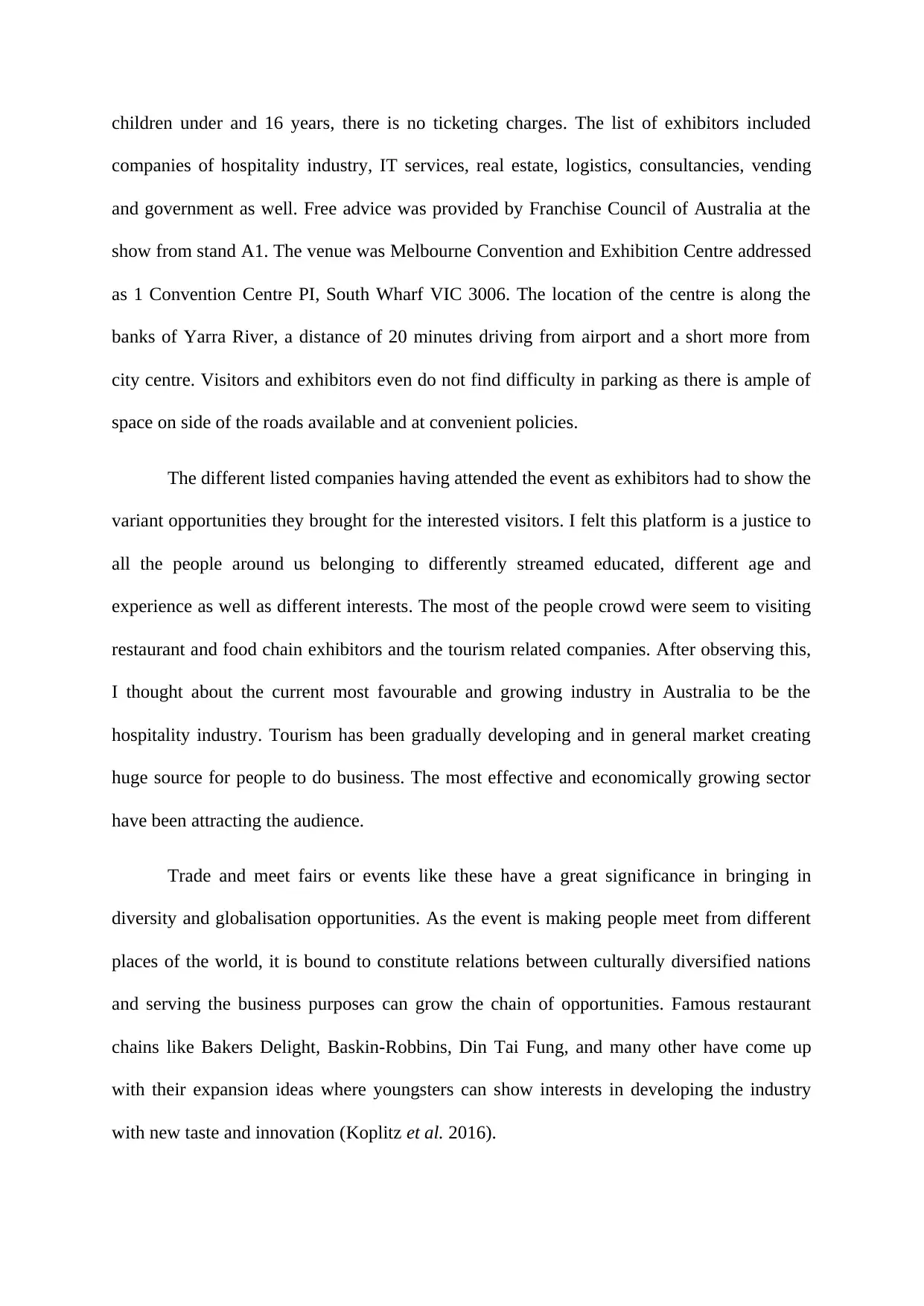
children under and 16 years, there is no ticketing charges. The list of exhibitors included
companies of hospitality industry, IT services, real estate, logistics, consultancies, vending
and government as well. Free advice was provided by Franchise Council of Australia at the
show from stand A1. The venue was Melbourne Convention and Exhibition Centre addressed
as 1 Convention Centre PI, South Wharf VIC 3006. The location of the centre is along the
banks of Yarra River, a distance of 20 minutes driving from airport and a short more from
city centre. Visitors and exhibitors even do not find difficulty in parking as there is ample of
space on side of the roads available and at convenient policies.
The different listed companies having attended the event as exhibitors had to show the
variant opportunities they brought for the interested visitors. I felt this platform is a justice to
all the people around us belonging to differently streamed educated, different age and
experience as well as different interests. The most of the people crowd were seem to visiting
restaurant and food chain exhibitors and the tourism related companies. After observing this,
I thought about the current most favourable and growing industry in Australia to be the
hospitality industry. Tourism has been gradually developing and in general market creating
huge source for people to do business. The most effective and economically growing sector
have been attracting the audience.
Trade and meet fairs or events like these have a great significance in bringing in
diversity and globalisation opportunities. As the event is making people meet from different
places of the world, it is bound to constitute relations between culturally diversified nations
and serving the business purposes can grow the chain of opportunities. Famous restaurant
chains like Bakers Delight, Baskin-Robbins, Din Tai Fung, and many other have come up
with their expansion ideas where youngsters can show interests in developing the industry
with new taste and innovation (Koplitz et al. 2016).
companies of hospitality industry, IT services, real estate, logistics, consultancies, vending
and government as well. Free advice was provided by Franchise Council of Australia at the
show from stand A1. The venue was Melbourne Convention and Exhibition Centre addressed
as 1 Convention Centre PI, South Wharf VIC 3006. The location of the centre is along the
banks of Yarra River, a distance of 20 minutes driving from airport and a short more from
city centre. Visitors and exhibitors even do not find difficulty in parking as there is ample of
space on side of the roads available and at convenient policies.
The different listed companies having attended the event as exhibitors had to show the
variant opportunities they brought for the interested visitors. I felt this platform is a justice to
all the people around us belonging to differently streamed educated, different age and
experience as well as different interests. The most of the people crowd were seem to visiting
restaurant and food chain exhibitors and the tourism related companies. After observing this,
I thought about the current most favourable and growing industry in Australia to be the
hospitality industry. Tourism has been gradually developing and in general market creating
huge source for people to do business. The most effective and economically growing sector
have been attracting the audience.
Trade and meet fairs or events like these have a great significance in bringing in
diversity and globalisation opportunities. As the event is making people meet from different
places of the world, it is bound to constitute relations between culturally diversified nations
and serving the business purposes can grow the chain of opportunities. Famous restaurant
chains like Bakers Delight, Baskin-Robbins, Din Tai Fung, and many other have come up
with their expansion ideas where youngsters can show interests in developing the industry
with new taste and innovation (Koplitz et al. 2016).
⊘ This is a preview!⊘
Do you want full access?
Subscribe today to unlock all pages.

Trusted by 1+ million students worldwide
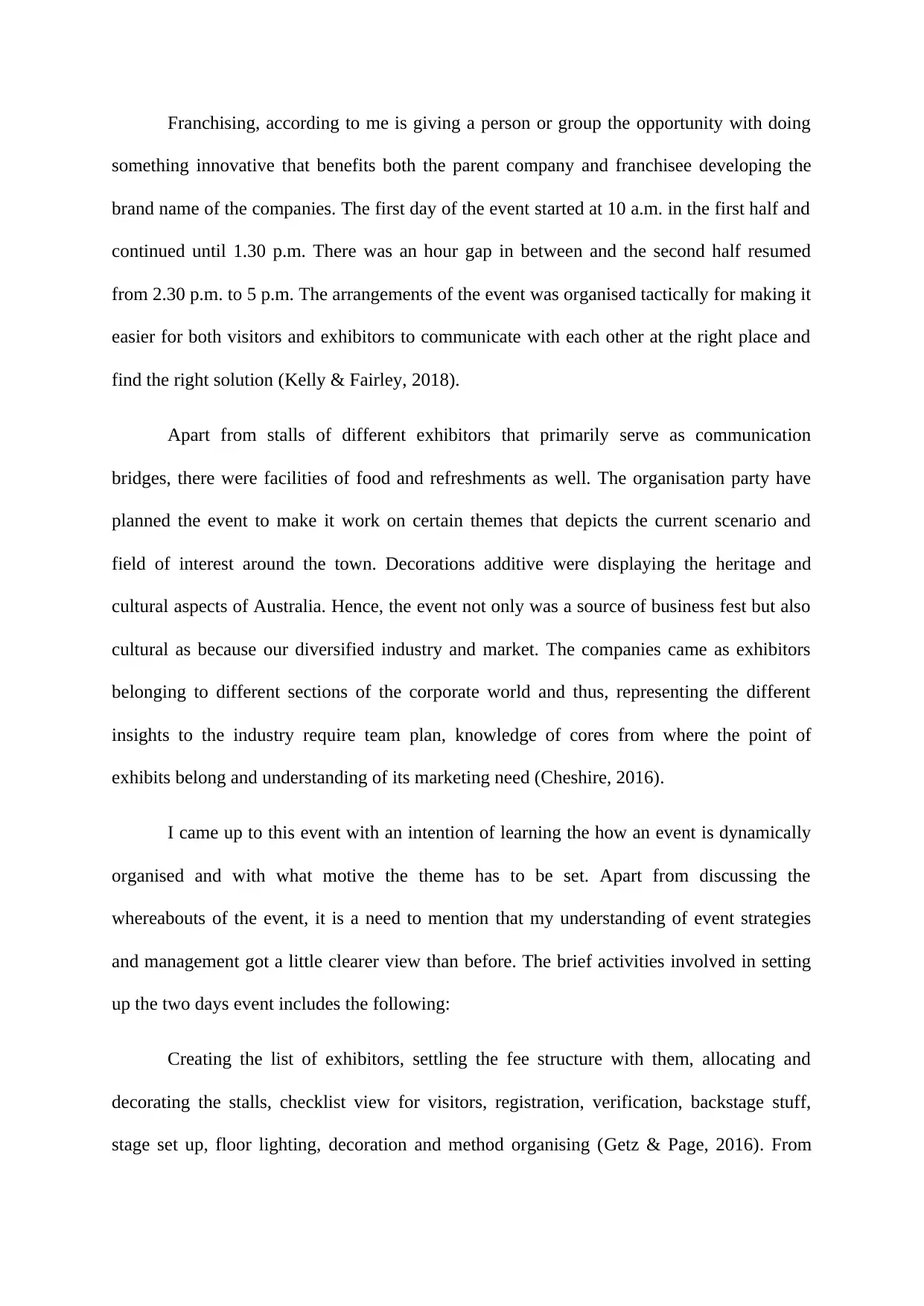
Franchising, according to me is giving a person or group the opportunity with doing
something innovative that benefits both the parent company and franchisee developing the
brand name of the companies. The first day of the event started at 10 a.m. in the first half and
continued until 1.30 p.m. There was an hour gap in between and the second half resumed
from 2.30 p.m. to 5 p.m. The arrangements of the event was organised tactically for making it
easier for both visitors and exhibitors to communicate with each other at the right place and
find the right solution (Kelly & Fairley, 2018).
Apart from stalls of different exhibitors that primarily serve as communication
bridges, there were facilities of food and refreshments as well. The organisation party have
planned the event to make it work on certain themes that depicts the current scenario and
field of interest around the town. Decorations additive were displaying the heritage and
cultural aspects of Australia. Hence, the event not only was a source of business fest but also
cultural as because our diversified industry and market. The companies came as exhibitors
belonging to different sections of the corporate world and thus, representing the different
insights to the industry require team plan, knowledge of cores from where the point of
exhibits belong and understanding of its marketing need (Cheshire, 2016).
I came up to this event with an intention of learning the how an event is dynamically
organised and with what motive the theme has to be set. Apart from discussing the
whereabouts of the event, it is a need to mention that my understanding of event strategies
and management got a little clearer view than before. The brief activities involved in setting
up the two days event includes the following:
Creating the list of exhibitors, settling the fee structure with them, allocating and
decorating the stalls, checklist view for visitors, registration, verification, backstage stuff,
stage set up, floor lighting, decoration and method organising (Getz & Page, 2016). From
something innovative that benefits both the parent company and franchisee developing the
brand name of the companies. The first day of the event started at 10 a.m. in the first half and
continued until 1.30 p.m. There was an hour gap in between and the second half resumed
from 2.30 p.m. to 5 p.m. The arrangements of the event was organised tactically for making it
easier for both visitors and exhibitors to communicate with each other at the right place and
find the right solution (Kelly & Fairley, 2018).
Apart from stalls of different exhibitors that primarily serve as communication
bridges, there were facilities of food and refreshments as well. The organisation party have
planned the event to make it work on certain themes that depicts the current scenario and
field of interest around the town. Decorations additive were displaying the heritage and
cultural aspects of Australia. Hence, the event not only was a source of business fest but also
cultural as because our diversified industry and market. The companies came as exhibitors
belonging to different sections of the corporate world and thus, representing the different
insights to the industry require team plan, knowledge of cores from where the point of
exhibits belong and understanding of its marketing need (Cheshire, 2016).
I came up to this event with an intention of learning the how an event is dynamically
organised and with what motive the theme has to be set. Apart from discussing the
whereabouts of the event, it is a need to mention that my understanding of event strategies
and management got a little clearer view than before. The brief activities involved in setting
up the two days event includes the following:
Creating the list of exhibitors, settling the fee structure with them, allocating and
decorating the stalls, checklist view for visitors, registration, verification, backstage stuff,
stage set up, floor lighting, decoration and method organising (Getz & Page, 2016). From
Paraphrase This Document
Need a fresh take? Get an instant paraphrase of this document with our AI Paraphraser

beginning to ending, wrapping up the entire program and creating communication sources,
the event management and strategies used in the organising seems to be planned efficiently.
the event management and strategies used in the organising seems to be planned efficiently.
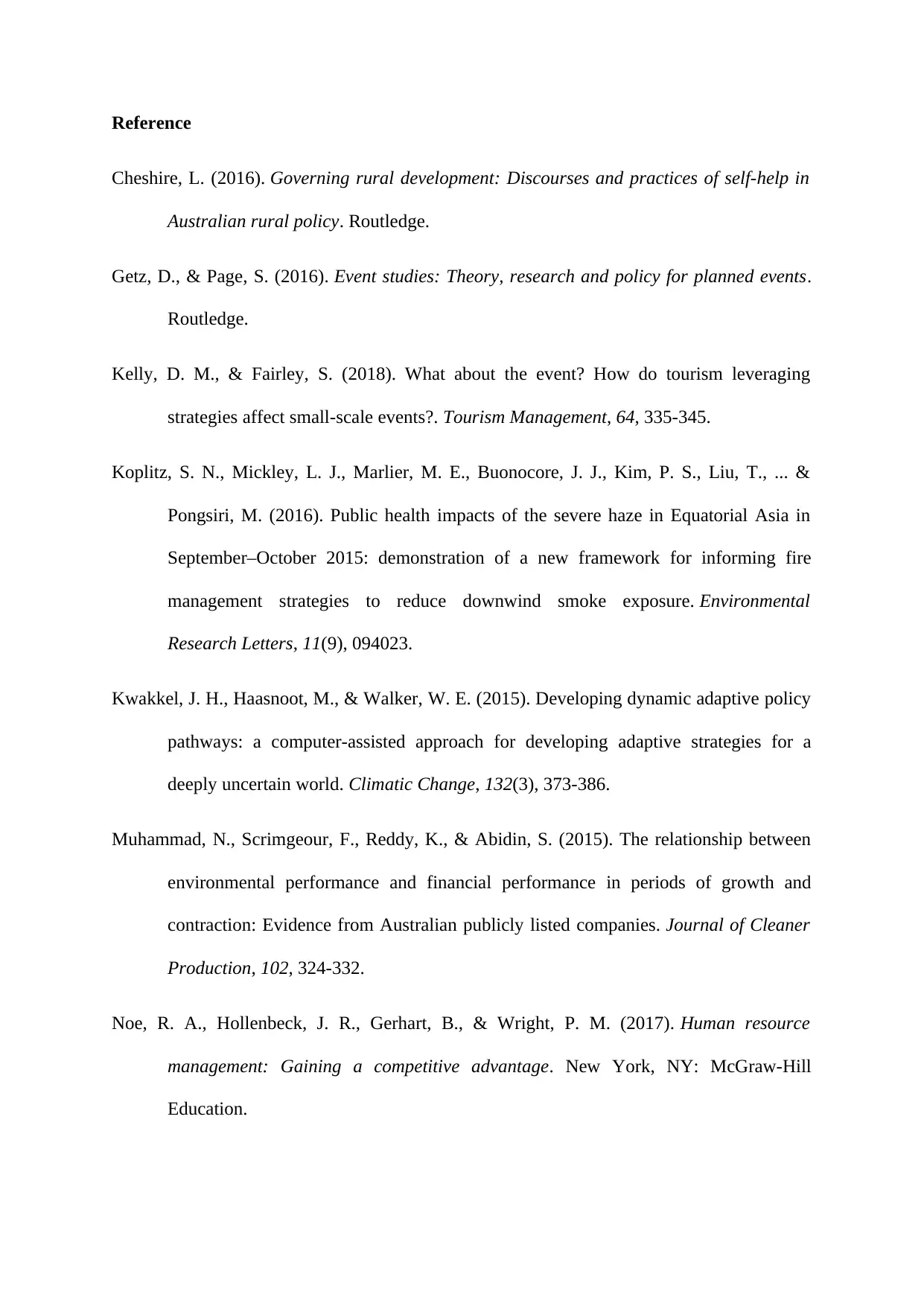
Reference
Cheshire, L. (2016). Governing rural development: Discourses and practices of self-help in
Australian rural policy. Routledge.
Getz, D., & Page, S. (2016). Event studies: Theory, research and policy for planned events.
Routledge.
Kelly, D. M., & Fairley, S. (2018). What about the event? How do tourism leveraging
strategies affect small-scale events?. Tourism Management, 64, 335-345.
Koplitz, S. N., Mickley, L. J., Marlier, M. E., Buonocore, J. J., Kim, P. S., Liu, T., ... &
Pongsiri, M. (2016). Public health impacts of the severe haze in Equatorial Asia in
September–October 2015: demonstration of a new framework for informing fire
management strategies to reduce downwind smoke exposure. Environmental
Research Letters, 11(9), 094023.
Kwakkel, J. H., Haasnoot, M., & Walker, W. E. (2015). Developing dynamic adaptive policy
pathways: a computer-assisted approach for developing adaptive strategies for a
deeply uncertain world. Climatic Change, 132(3), 373-386.
Muhammad, N., Scrimgeour, F., Reddy, K., & Abidin, S. (2015). The relationship between
environmental performance and financial performance in periods of growth and
contraction: Evidence from Australian publicly listed companies. Journal of Cleaner
Production, 102, 324-332.
Noe, R. A., Hollenbeck, J. R., Gerhart, B., & Wright, P. M. (2017). Human resource
management: Gaining a competitive advantage. New York, NY: McGraw-Hill
Education.
Cheshire, L. (2016). Governing rural development: Discourses and practices of self-help in
Australian rural policy. Routledge.
Getz, D., & Page, S. (2016). Event studies: Theory, research and policy for planned events.
Routledge.
Kelly, D. M., & Fairley, S. (2018). What about the event? How do tourism leveraging
strategies affect small-scale events?. Tourism Management, 64, 335-345.
Koplitz, S. N., Mickley, L. J., Marlier, M. E., Buonocore, J. J., Kim, P. S., Liu, T., ... &
Pongsiri, M. (2016). Public health impacts of the severe haze in Equatorial Asia in
September–October 2015: demonstration of a new framework for informing fire
management strategies to reduce downwind smoke exposure. Environmental
Research Letters, 11(9), 094023.
Kwakkel, J. H., Haasnoot, M., & Walker, W. E. (2015). Developing dynamic adaptive policy
pathways: a computer-assisted approach for developing adaptive strategies for a
deeply uncertain world. Climatic Change, 132(3), 373-386.
Muhammad, N., Scrimgeour, F., Reddy, K., & Abidin, S. (2015). The relationship between
environmental performance and financial performance in periods of growth and
contraction: Evidence from Australian publicly listed companies. Journal of Cleaner
Production, 102, 324-332.
Noe, R. A., Hollenbeck, J. R., Gerhart, B., & Wright, P. M. (2017). Human resource
management: Gaining a competitive advantage. New York, NY: McGraw-Hill
Education.
⊘ This is a preview!⊘
Do you want full access?
Subscribe today to unlock all pages.

Trusted by 1+ million students worldwide
1 out of 6
Related Documents
Your All-in-One AI-Powered Toolkit for Academic Success.
+13062052269
info@desklib.com
Available 24*7 on WhatsApp / Email
![[object Object]](/_next/static/media/star-bottom.7253800d.svg)
Unlock your academic potential
Copyright © 2020–2025 A2Z Services. All Rights Reserved. Developed and managed by ZUCOL.



